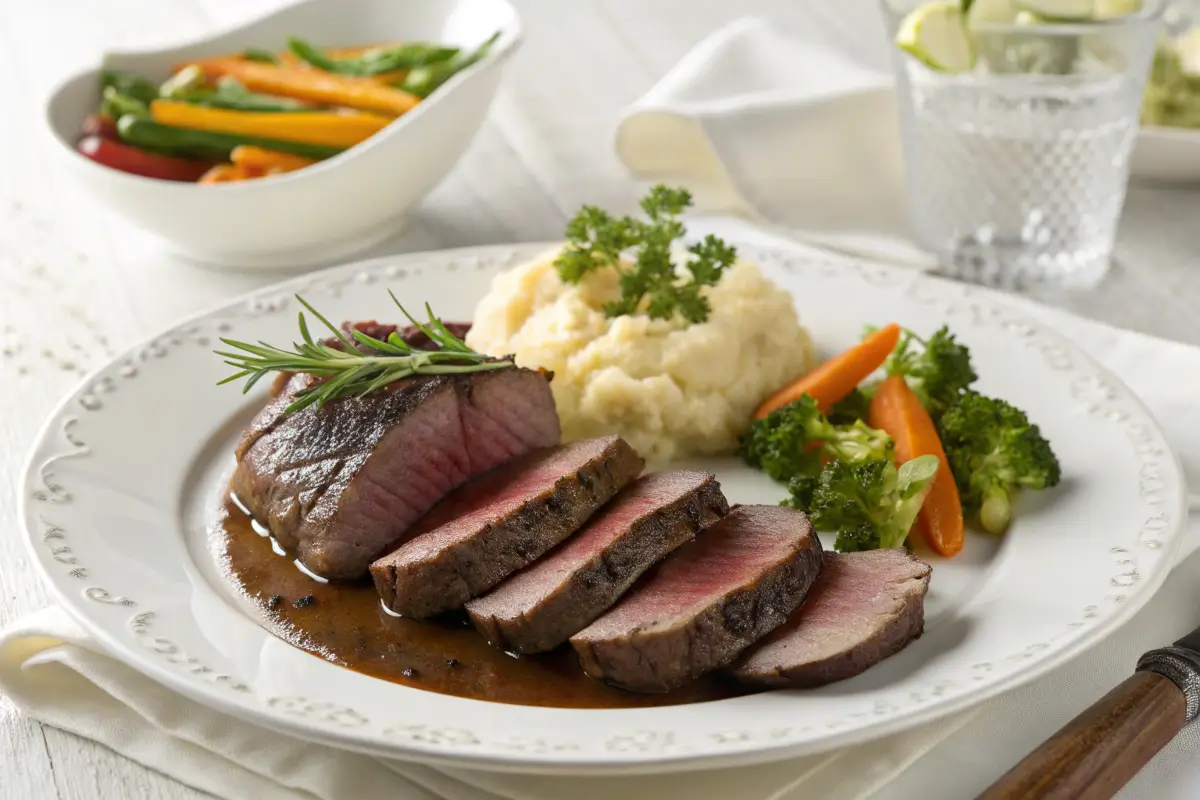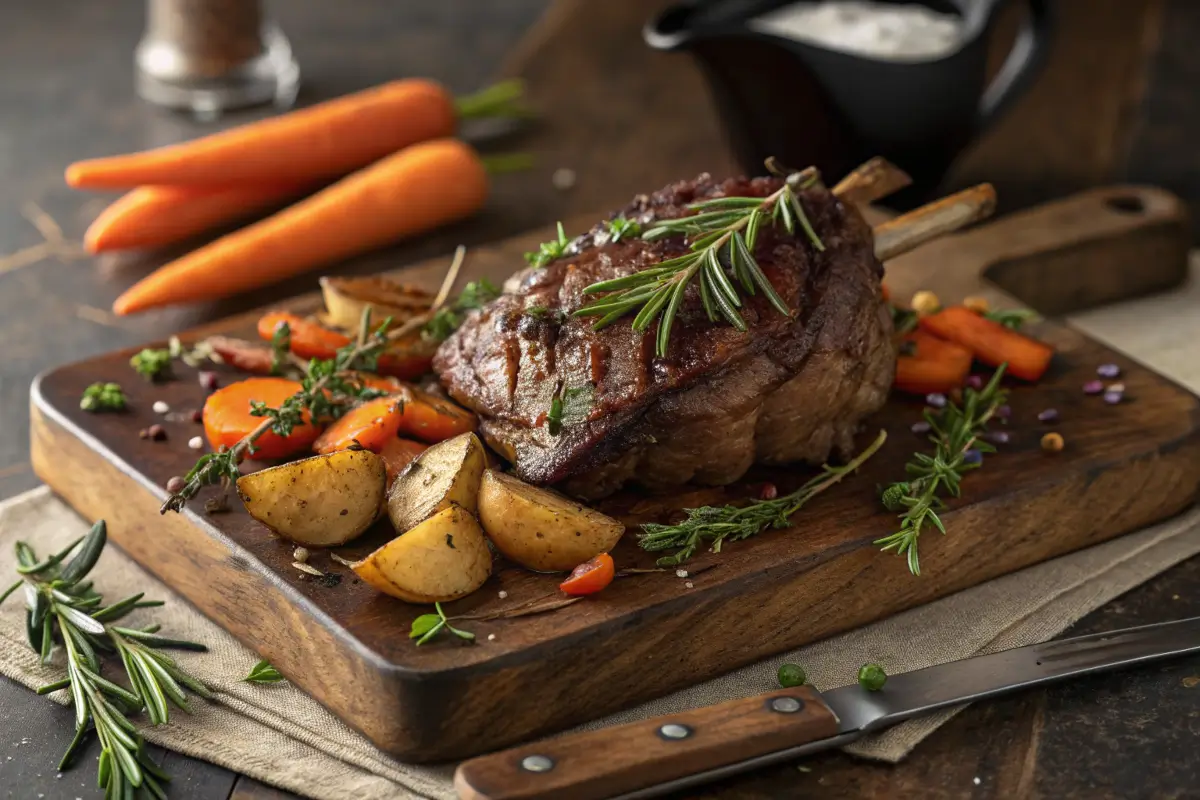Roasting venison can be a delicious and rewarding culinary adventure, but getting it just right often feels like a challenge. From determining the perfect cooking time to ensuring a tender, juicy result, there’s a lot to consider. This comprehensive guide will walk you through every step of roasting venison, covering essential tips, techniques, and troubleshooting advice. By the end, you’ll know exactly how long you should roast venison for and how to make it taste amazing. Let’s get started!
Understanding Venison and Roasting Basics
What is Venison?
Venison refers to meat from deer, and it’s a lean, flavorful alternative to traditional beef or pork. Its unique taste, often described as earthy and rich, makes it a prized choice for special meals. Since venison is much leaner than most meats, it requires careful handling to ensure tenderness and avoid dryness.
Why Roasting is Ideal for Venison?
Roasting venison is one of the best ways to cook it, as it allows the meat to retain its natural juices while developing a beautifully browned exterior. The oven’s consistent heat creates a perfect environment for low and slow cooking or quick roasting at higher temperatures. Roasting also enhances venison’s inherent flavors and allows you to customize seasoning and marinades to suit your palate.
Essential Tools and Ingredients for Roasting Venison
Before you begin, gather these tools to ensure a seamless process:
- Roasting Pan: A sturdy pan with a rack is essential for even cooking.
- Meat Thermometer: Accurate temperatures are key to avoiding overcooking.
- Sharp Knife: For trimming and carving.
For ingredients, keep it simple: a good cut of venison, salt, pepper, olive oil, and any herbs or marinades of your choice. The lean nature of venison pairs beautifully with rosemary, thyme, and garlic.
Determining Cooking Times for Venison
Factors Influencing Roasting Time
When asking how long should I roast venison for, several variables come into play. The most important factors include the weight, cut, and whether the venison is bone-in or boneless.
- Weight and Size of Venison
Larger cuts, such as a whole venison shoulder or leg, take longer to cook than smaller cuts like a tenderloin. A general rule of thumb is to roast at 325°F for 20–25 minutes per pound for medium-rare results. - Bone-In vs. Boneless Cuts
Bone-in cuts often take slightly longer to cook because bones retain heat and impact the overall roasting time. However, they also contribute to a richer flavor.
Recommended Internal Temperature for Venison
Venison’s lean structure requires careful attention to avoid overcooking. The ideal internal temperature is:
- Rare: 125–130°F
- Medium-Rare: 130–135°F (most recommended)
- Medium: 135–145°F
Use a meat thermometer to check the thickest part of the cut to ensure accuracy.
Quick Reference Roasting Time Chart
Here’s a handy guide:
- Small Cuts (1–2 lbs): 30–40 minutes at 400°F
- Medium Cuts (2–4 lbs): 1–1.5 hours at 350°F
- Large Cuts (5+ lbs): 2–3 hours at 325°F
For more details on roasting times and techniques, check out Venison Roast Recipe Guide, which offers additional tips.
Preparing Venison for Roasting
Trimming and Cleaning the Meat
Proper preparation is key to achieving a succulent roast. Start by trimming excess fat and sinew from your venison. Unlike beef, venison fat has a waxy texture that can create an unpleasant taste if left intact.
Marinating Venison for Flavor and Tenderness
Marinating venison is an optional but highly recommended step. A good marinade can not only enhance the flavor but also tenderize the lean meat. Popular ingredients for marinades include:
- Red wine or balsamic vinegar
- Olive oil
- Garlic, rosemary, and thyme
Let the venison sit in the marinade for at least 4–8 hours, or overnight for deeper flavor.
Seasoning Options for Roasting Venison
Simple seasonings often work best. Rub the meat with olive oil, salt, pepper, and your favorite herbs before roasting. Adding a touch of sweetness, like brown sugar or honey, can balance the earthy flavors of the meat.
For more creative seasoning options, you can explore combinations inspired by this Balsamic Chicken Recipe, which offers insights into balancing savory and tangy notes.
Step-by-Step Guide to Roasting Venison
Preheating the Oven and Preparing the Roasting Pan

Before you even season the meat, set your oven to the correct temperature. Venison is best roasted at 325°F for slow cooking or 400°F for a quicker sear and roast method. Preheating ensures the meat starts cooking evenly the moment it’s placed in the oven.
Prepare a roasting pan with a rack to elevate the meat, allowing hot air to circulate underneath. If you don’t have a rack, use a bed of vegetables like carrots, celery, and onions. This not only prevents the venison from sticking but also creates a delicious base for gravy.
Searing Venison Before Roasting: Why and How
Searing venison is a small step with big results. Heat a skillet over medium-high heat and add a drizzle of oil. Sear the meat for 2–3 minutes on each side until it develops a golden-brown crust. This locks in the juices and enhances the flavor.
If you’ve never seared meat before, think of it as an essential move to add depth and richness. Just be sure not to overcrowd the pan; work in batches if necessary.
How Long Should You Roast Venison For?
Now comes the big question: how long should I roast venison for? The answer depends on the cut and weight. For a medium-rare finish, follow this general guide:
- 1–2 lbs: 30–40 minutes at 400°F
- 3–4 lbs: 1–1.5 hours at 350°F
- 5+ lbs: 2–3 hours at 325°F
Always use a meat thermometer to check doneness, aiming for 130–135°F for medium-rare. Rest the meat for at least 10 minutes before carving to allow juices to redistribute.
For more details on roasting times and tips, you can explore this comprehensive Venison Roast Recipe Guide.
Troubleshooting and Enhancing the Roasting Process
Common Mistakes in Roasting Venison
Even seasoned cooks can make mistakes. To avoid common pitfalls:
- Overcooking: Venison is lean, so it dries out quickly. Use a thermometer to avoid guessing.
- Skipping Rest Time: Cutting too soon causes juices to escape. Always rest for 10–15 minutes.
- Underseasoning: Venison has a robust flavor, so don’t be shy with herbs and spices.
If your roast ends up dry, slice it thinly and serve it with a rich gravy or sauce to restore some moisture.
Tips for Achieving Perfectly Roasted Venison
- Choose the Right Pan: A sturdy roasting pan ensures even heat distribution.
- Use Aromatics: Fresh garlic, rosemary, and thyme can take the flavor to the next level.
- Add Moisture: Cover the meat loosely with foil for the first half of roasting to retain moisture.
For an additional twist, try pairing your venison with a side inspired by Southern Cornbread Recipe. The savory-sweet balance complements venison beautifully.
Serving and Pairing Roasted Venison
Best Side Dishes to Complement Venison

The right side dishes can elevate your roasted venison from delicious to unforgettable. Because venison has a rich, earthy flavor, pair it with sides that balance its leanness. Some excellent options include:
- Root Vegetables: Roasted carrots, parsnips, and sweet potatoes add natural sweetness that complements venison’s robust taste.
- Creamy Mashed Potatoes: This classic comfort food pairs beautifully with a hearty gravy made from venison drippings.
- Savory Stuffing or Wild Rice: Both options offer textures and flavors that blend well with roasted venison.
For a Southern-inspired pairing, try a cornbread recipe like the Southern Cornbread Recipe. Its sweet-savory profile is a match made in culinary heaven.
How to Carve and Serve Venison Roast
Once your venison has rested for at least 10 minutes, it’s time to carve. Use a sharp knife to slice against the grain for maximum tenderness. Serve the slices on a warm platter with a drizzle of gravy or a side of cranberry chutney for a festive touch.
If you’re wondering how long should I roast venison for, remember that carving and serving are equally important for the perfect dining experience. A beautiful presentation enhances the overall appeal of your meal.
FAQs on Roasting Venison
How Do You Know When Venison is Done?
Venison is done when it reaches your desired internal temperature. For medium-rare, aim for 130–135°F. Always check the thickest part of the roast with a thermometer to ensure accuracy.
What’s the Best Way to Prevent Overcooking?
To prevent overcooking, use a meat thermometer and monitor closely during roasting. Covering the venison loosely with foil can also help retain moisture.
Can You Roast Venison Without Marinating?
Yes, but marinating adds flavor and tenderness, which are especially helpful for lean cuts. If you skip the marinade, be sure to season generously with salt, pepper, and your favorite herbs.
Is Venison Better Cooked Rare or Well-Done?
Venison is best enjoyed medium-rare to medium. Overcooking to well-done can make the meat tough and dry, so aim for a gentle, pink interior.
For more venison ideas and tips, check out this comprehensive Venison Roast Recipe Guide.
Tips for Storing and Reheating Roasted Venison
How to Properly Store Leftover Venison
If you find yourself with leftovers after mastering how long should I roast venison for, storing them correctly is essential to maintain their flavor and texture.
- Refrigeration: Place leftover venison in an airtight container or tightly wrap it in foil. Store it in the fridge for up to 3–4 days.
- Freezing: For longer storage, wrap the meat tightly in freezer-safe wrap or vacuum-seal it. Properly stored, venison can last up to 3 months in the freezer without losing quality.
Before storing, allow the meat to cool completely to prevent condensation, which can affect texture and freshness.
Reheating Without Drying Out
Reheating venison can be tricky due to its lean nature, but a few techniques will ensure it stays tender:
- Oven Reheat: Place the meat in a covered dish with a small amount of broth or gravy. Heat it in the oven at 275°F for 10–15 minutes, or until warmed through.
- Stovetop Reheat: Slice the venison thinly and warm it in a skillet over low heat with a splash of liquid.
Avoid reheating venison in the microwave, as this method often results in uneven heating and dryness. By taking these steps, you can enjoy the same rich, delicious flavors as when the venison was first roasted.
Final Thoughts and Suggestions
Roasting venison is more than just a cooking method; it’s an art form that allows the rich, earthy flavors of the meat to shine. Whether you’re hosting a holiday dinner or preparing a weeknight meal, knowing how long should I roast venison for ensures you’ll achieve perfection every time.
Throughout this guide, we’ve explored essential tips for preparing, seasoning, and serving venison. From marinating for tenderness to carving like a pro, each step plays a crucial role in crafting a memorable dish. Remember to always use a meat thermometer to achieve your desired doneness and let the meat rest to preserve its juices.
If you’re looking for more inspiration, check out the Venison Roast Recipe Guide for even more ideas to elevate your cooking. With practice and attention to detail, roasting venison can become one of your go-to specialties, delighting your family and friends for years to come.
So, the next time you’re wondering how to roast venison perfectly, come back to this guide and enjoy the journey to a mouthwatering meal!

